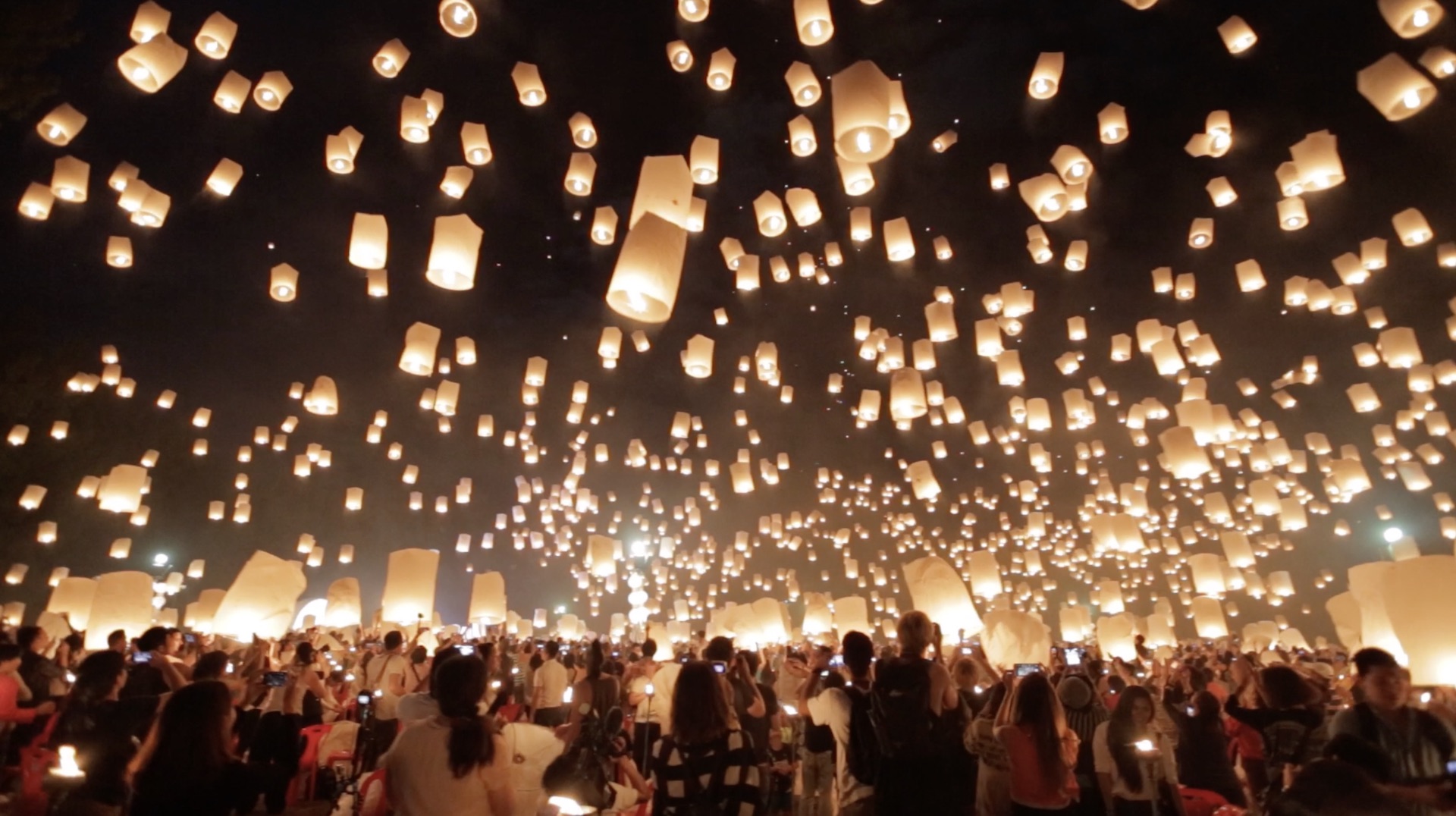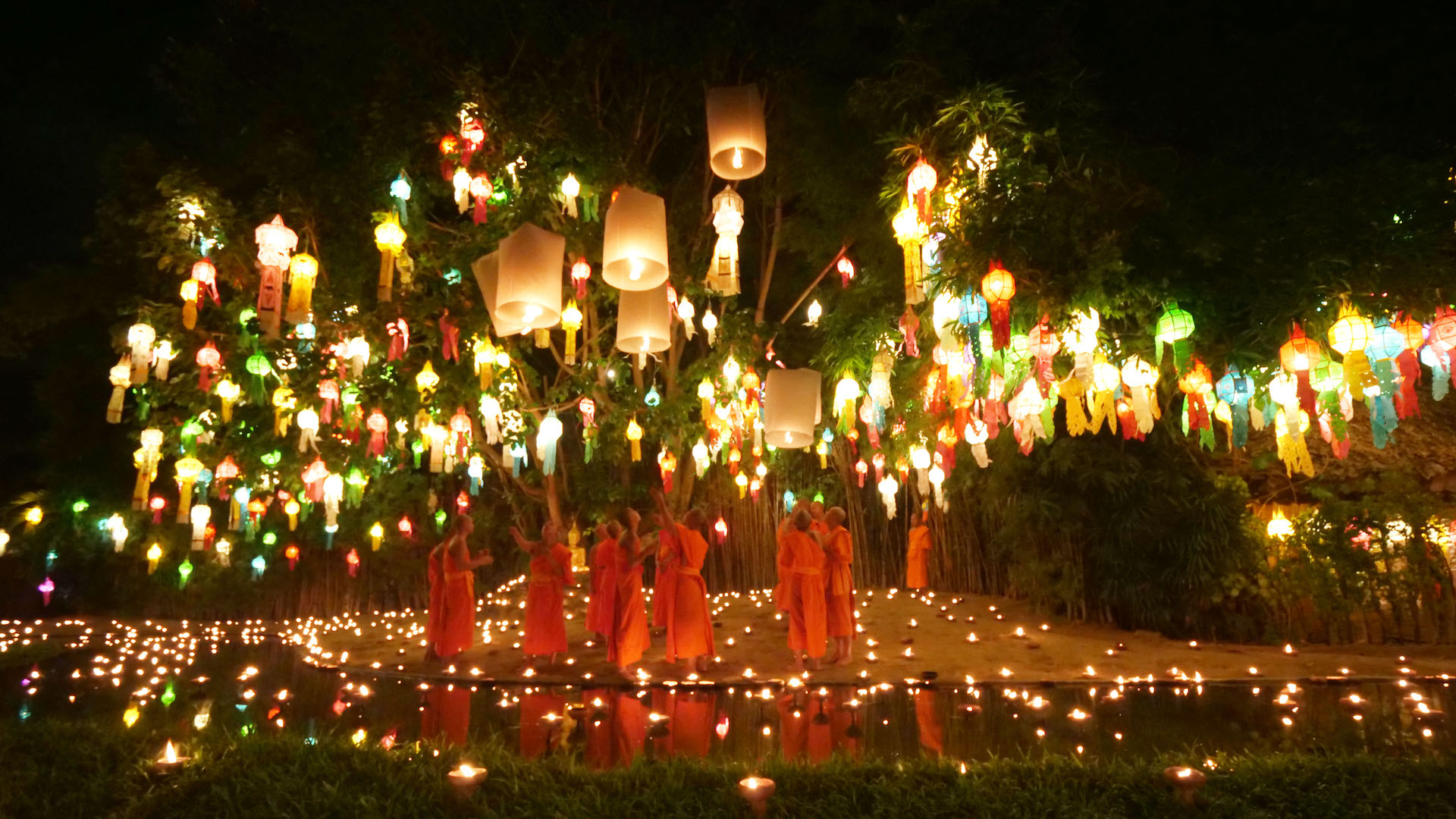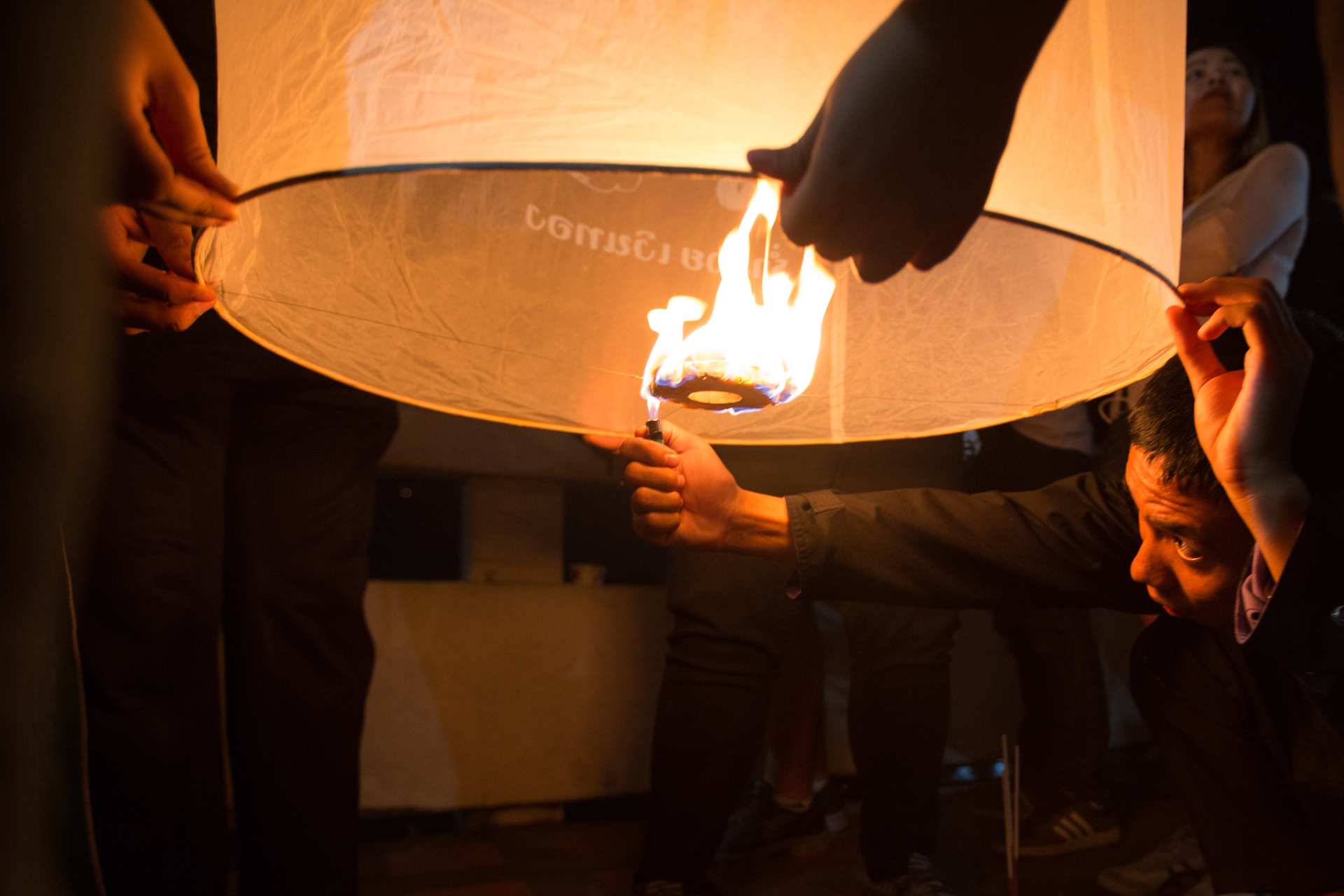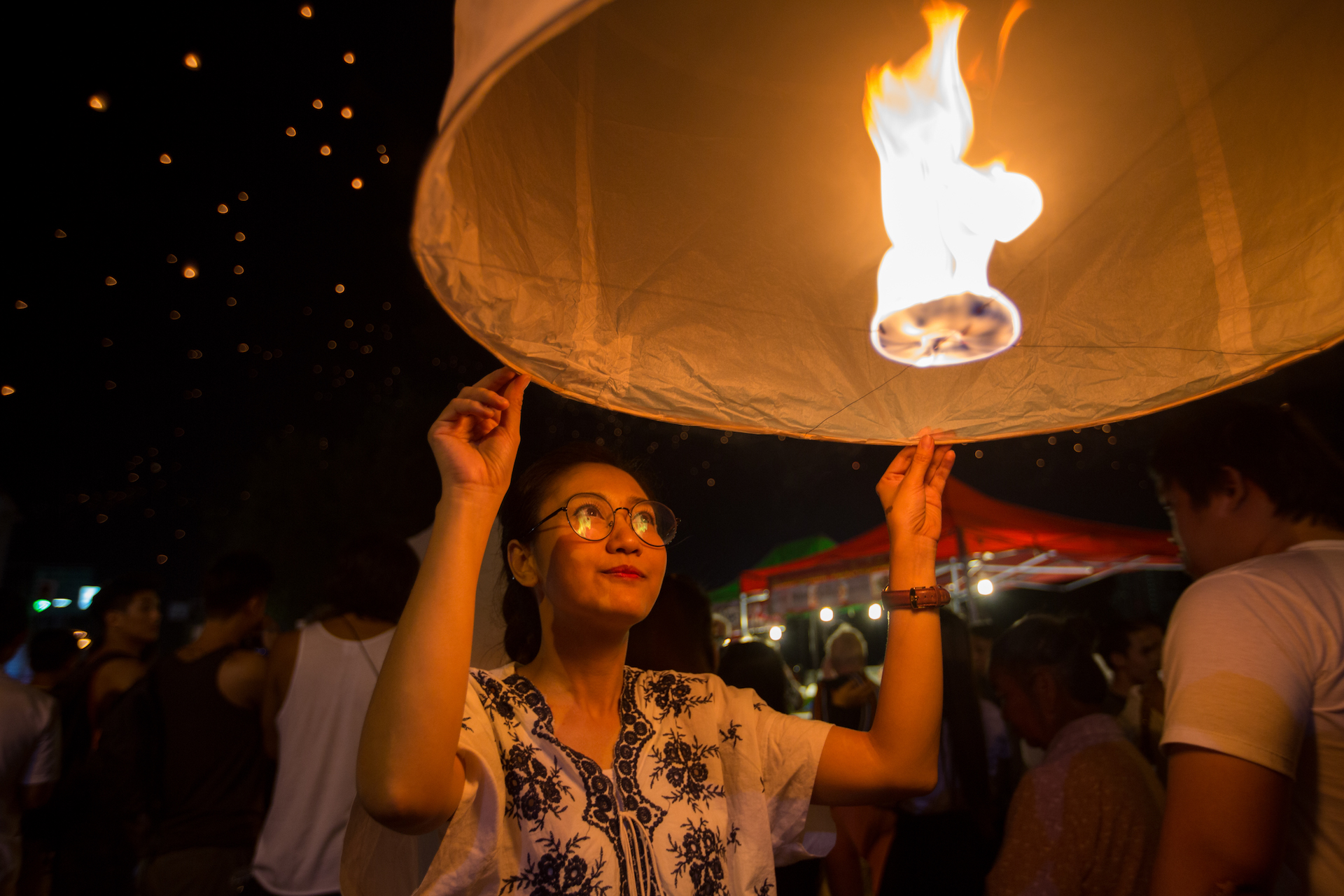Every November, thousands of lanterns leave outstretched hands and hearts. And as they rise, they’re lulled upward by the wind to join an airborne caravan of lanterns that have already begun their pilgrimage toward the heavens. They look like a chorus of fireflies in the night sky.
Each year in Thailand, thousands of Thais and tourists alike release lanterns made of rice paper and bamboo during the Yi Peng festival, beautifully featured in the Disney movie, Tangled. Some participants want merit, some want to check off something on a bucket list. All want to be mesmerized by an experience that feels transcendent.

Thais and tourists release their lanterns for the Loy Krathong festival. Photo by Andrew Rivers.
The Yi Peng festival coincides with another Thai Buddhist festival, Loy Krathong, and both festivals are usually grouped under the name, Loy Krathong. Traditionally, releasing a lantern called a khom loi into the air, or a basket called a krathong into waterways, is seen as a way to make merit and is a symbolic act of releasing sin. Thai Buddhists will usually say a prayer and make a wish before letting go of the lantern or baskets.
There are several locations in northern Thailand that host mass lantern releases. At these sites, monks recite mantras before and during the release. A historic temple in the center of Chiang Mai’s old city draws tourists and locals who come to photograph the lanterns and the monks releasing the lanterns. During the festival, long, hanging lanterns line the streets of some communities, and the exterior of some homes are decorated with intricate lanterns.

Thai Buddhist monks release krathongs during the Loy Krathong festival in Thailand. Photo by Andrew Rivers.
What Goes Up
Though the act of releasing a lantern to loose one’s sin is symbolic, the idea behind our need, desire, and ability to be free of sin is a reality most humans grapple with.
The lantern goes up with all of the hard work of igniting the wax ring and waiting until there’s enough heated air to carry it upward. But the lantern will eventually sink back to earth. And that’s symbolic too.

A young man ignites the wax ring of his lantern during the Loy Krathong festival in Thailand. Photo by Caroline Anderson.
The thing about releasing sins is, they always come back to you. What goes up must come down, and without Christ’s divine intervention, our manmade attempts to rid our lives of sin won’t be enough to bind us to heaven. Our sins end up littering our lives, not unlike the ugly, wilted, and deflated lanterns strewed across the beautiful Thai landscape the morning after their release.
Taking Off
In recent years, as the festival has become more widely and internationally known, thousands of tourists have flocked to Chiang Mai, the largest city in northern Thailand. Disney’s brilliant animation can take some credit for the increased public exposure. However, the explosion of social media, nomadic lifestyles, and the Thai government’s focus on increasing tourism elevated the lantern festival to a must-see event.
In recent years, tourists have likely outnumbered the locals. People come from all around the world to experience the festival, which has shifted the focal point from religion to wanderlust. Loy Krathong has become more secularized and is a sought-after Instagram trophy or bucket list entry.
In Chiang Mai, vendors selling food, drinks, and krathongs line the east side of the Ping River. The focal point for festivities centers around bridges over the river. Clusters of men, women, and children gather to light the wicks, take photos, perhaps say a prayer, and then release their lanterns—hoping they don’t catch fire first, run into electrical lines, plummet into the river, or become tangled in a tree. People cheer for friends’ and strangers’ successfully released lanterns.
For many Thais, because of globalization, and secularization, Yi Peng is now a cultural tradition. Releasing lanterns is simply a fun thing to do with family and friends. Perhaps the shift in the weightiness of the festival is a sign of the diminishing importance of the original, spiritual intent of the festival.
However, the religious aspect does remain. Many Thais do still view it as good luck or symbolic of releasing sin.

A young woman prepares to release her lantern during the Yi Ping festival in Thailand. Photo by Caroline Anderson.
Hovering Truth
The religious origin of the festival poses a slight dilemma for Thai Christians trying to live as light in a dark world. Some Thai believers will light lanterns simply because it’s fun, but they don’t pray or see it as a merit-making venture. Other Christians choose not to participate so as to not have any semblance of conformity with Buddhist tradition.
Most all Thai Christians draw the line at releasing krathongs into the river. This tradition has still remained closely intertwined with Buddhism and is recognized as appeasing the spirits, which is a fear that lurks in the Thai Buddhist’s mind.
In the West, we also see the commercialization and secularization of religious holidays, Christmas and Easter being prime examples. Whether American Christians choose to include Santa Claus and the Easter bunny in their celebrations of Christmas or Easter is similar to the decision Thai Christians make in whether to release lanterns during Yi Peng.
There is an opportunity with holidays of other faiths to be a light in the darkness and a witness to the pervading light we have as Christians. When we’re considering whether to participate, it’s important to keep in mind whether there would be an opportunity to bear witness to the gospel. Observing and understanding religious festivals allows us to enter into intelligent conversations with non-Christians. We cannot reason against what we do not know or understand.
Is there an aspect of the holiday that can be redeemed? Echoes of eternity and biblical allegories exist in all cultures—finding them is a treasure hunt. We all came from the same man and woman, and stories of creation, victory over evil, and redemption exist in every society.
There are tremendous opportunities to speak truth into the void people are looking to fill through these festivals and holidays. Being present with non-Christians during festivals could lead to faith-centered conversations that may be awkward to engineer in everyday conversation.
If we Christians choose to release fear of the unknown, we could discover bridges to sharing the gospel that might be hovering just above us—like paper lanterns in the sky.
Caroline Anderson is a writer and photographer with the IMB. She currently lives in Southeast Asia. Her childhood in Asia consisted of two important ingredients: braving hot chili peppers and telling people about Jesus.
Video by Andrew Rivers, who lives with his wife in Southeast Asia.

